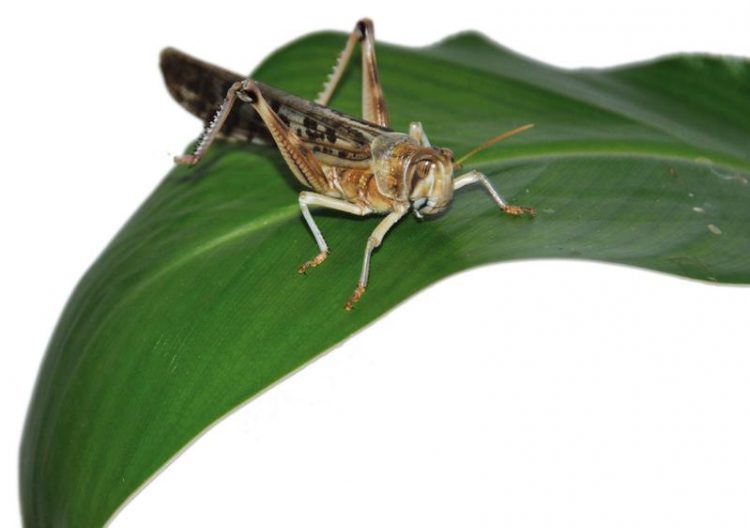Locusts at the wheel: University of Graz investigates collision detector inspired by insect eyes

Locusts of the species schistocerca gregaria can react extremely quickly to impending collisions. Its neurons are a model für technology. Uni Graz
Inspired by insects
Migratory locusts travel in swarms of up to 1.5 million individuals, moving like a single organism and reacting quickly to predators. “If a bird dives into a swarm, the unit divides and the predator hits thin air” explains Hartbauer.
This quick coordination is made possible by special visual collision detectors. Locusts possess a neuron in the lobula of each compound eye that reacts to impending collisions by increased excitation. Its level directly influences flight behaviour.
The zoologist undertook laboratory tests in which he showed confronted individual insects with short traffic videos of showing serious collisions from the driver’s perspective. At the same time he recorded the excitation of “collision detector neurones”.
The results were so impressive that Hartbauer developed a computer model that is able to recognise impending collisions using image sequences with low optical resolution as input to calculate the braking force and a possible evasive steering direction.
Technical implementation
“At the moment, the patentability of this method of collision detection is being checked, with the aim of moving onto technical implementation within the framework of an interdisciplinary project,” explained Hartbauer. The aim is to develop an innovative sensor concept indicating imminent collisions at day and night making use of patented nanotechnology from Joanneum Research.
“If this is successful, autonomous cars and driver assistance systems will be able to make use of an affordable collision sensor system, which will reduce the number of traffic accidents drastically,” said Hartbauer.
The zoologist also plans to work together with the Vehicle Safety Institute at Graz University of Technology to develop a driver assistance assistant system inspired by the effective locust collision avoidance behaviour. The project will soon be submitted to the Austrian Science Fund and is part of the “Brain and Behaviour” research focus at the University of Graz.
For further enquiries please contact:
Assoz. Prof. Dr. Manfred Hartbauer
Institute of Zoology
University of Graz
Tel.: 0316/380-5616
E-Mail: manfred.hartbauer@uni-graz.at
Media Contact
More Information:
http://www.uni-graz.atAll latest news from the category: Life Sciences and Chemistry
Articles and reports from the Life Sciences and chemistry area deal with applied and basic research into modern biology, chemistry and human medicine.
Valuable information can be found on a range of life sciences fields including bacteriology, biochemistry, bionics, bioinformatics, biophysics, biotechnology, genetics, geobotany, human biology, marine biology, microbiology, molecular biology, cellular biology, zoology, bioinorganic chemistry, microchemistry and environmental chemistry.
Newest articles

A universal framework for spatial biology
SpatialData is a freely accessible tool to unify and integrate data from different omics technologies accounting for spatial information, which can provide holistic insights into health and disease. Biological processes…

How complex biological processes arise
A $20 million grant from the U.S. National Science Foundation (NSF) will support the establishment and operation of the National Synthesis Center for Emergence in the Molecular and Cellular Sciences (NCEMS) at…

Airborne single-photon lidar system achieves high-resolution 3D imaging
Compact, low-power system opens doors for photon-efficient drone and satellite-based environmental monitoring and mapping. Researchers have developed a compact and lightweight single-photon airborne lidar system that can acquire high-resolution 3D…





















